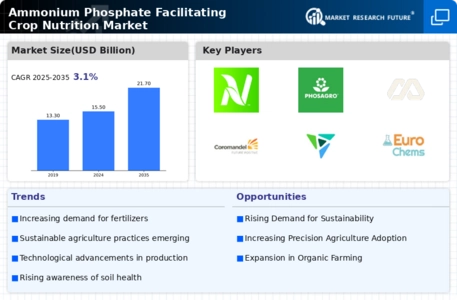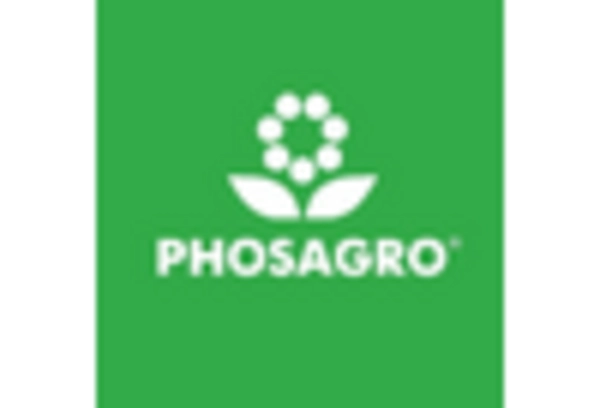Growing Awareness of Soil Health
There is a burgeoning awareness regarding soil health and its critical role in sustainable agriculture, which is positively impacting the Ammonium Phosphate Facilitating Crop Nutrition Market. Farmers are increasingly recognizing that healthy soil is fundamental to achieving optimal crop yields. Ammonium phosphate is known to enhance soil fertility by providing essential nutrients, thus improving soil structure and microbial activity. Recent studies indicate that the application of ammonium phosphate can lead to a 30% increase in soil nutrient availability. This growing emphasis on soil health is prompting farmers to invest in high-quality fertilizers, including ammonium phosphate, to ensure long-term agricultural sustainability. As awareness continues to spread, the market for ammonium phosphate is expected to expand, driven by the need for effective soil management practices.
Rising Demand for Food Production
The increasing global population necessitates a substantial rise in food production, thereby driving the Ammonium Phosphate Facilitating Crop Nutrition Market. As agricultural practices evolve, the need for efficient fertilizers becomes paramount. Ammonium phosphate, known for its high nutrient content, plays a crucial role in enhancing crop yields. According to recent data, the demand for ammonium phosphate fertilizers is projected to grow at a compound annual growth rate of approximately 4.5% over the next five years. This growth is largely attributed to the need for sustainable agricultural practices that ensure food security while minimizing environmental impact. Farmers are increasingly adopting ammonium phosphate to improve soil fertility and crop productivity, indicating a robust market potential for this fertilizer type.
Government Initiatives and Subsidies
Government policies and initiatives aimed at promoting sustainable agriculture are pivotal in shaping the Ammonium Phosphate Facilitating Crop Nutrition Market. Many governments are implementing subsidies and incentives for the use of environmentally friendly fertilizers, including ammonium phosphate. These initiatives encourage farmers to adopt practices that enhance soil health and crop productivity. For instance, certain regions have reported a 15% increase in the use of ammonium phosphate fertilizers due to government-backed programs. Such support not only alleviates the financial burden on farmers but also aligns with global sustainability goals. As these policies continue to evolve, they are likely to further stimulate the demand for ammonium phosphate, reinforcing its position in the agricultural sector.
Shift Towards Organic Farming Practices
The shift towards organic farming practices is emerging as a significant driver for the Ammonium Phosphate Facilitating Crop Nutrition Market. As consumers increasingly demand organic produce, farmers are adapting their practices to meet these preferences. Ammonium phosphate, while traditionally used in conventional farming, is also being recognized for its potential in organic farming systems when used judiciously. The market for organic fertilizers is projected to grow at a rate of 5% annually, with ammonium phosphate playing a role in bridging the gap between conventional and organic practices. This transition not only supports sustainable agriculture but also enhances the market for ammonium phosphate as farmers seek to maintain productivity while adhering to organic standards. The dual role of ammonium phosphate in both conventional and organic farming could lead to a broader acceptance and utilization of this fertilizer.
Technological Innovations in Fertilizer Application
Technological advancements in agriculture are significantly influencing the Ammonium Phosphate Facilitating Crop Nutrition Market. Innovations such as precision agriculture and smart farming techniques enable farmers to apply fertilizers more efficiently, optimizing nutrient use and minimizing waste. The integration of drones and satellite imagery allows for precise application of ammonium phosphate, ensuring that crops receive the right amount of nutrients at the right time. This not only enhances crop yields but also reduces environmental impact. Market data suggests that the adoption of such technologies could lead to a 20% increase in fertilizer efficiency, thereby boosting the overall demand for ammonium phosphate fertilizers. As farmers seek to maximize productivity while adhering to sustainable practices, the role of technology in fertilizer application becomes increasingly critical.


















Leave a Comment